Some people think that history, or at least history since the enlightenment, can be characterized as a process of consistent long run improvement even if there have been occasional bumps on the road. This is sometimes called a Whig view of history and is probably most famously championed today by Steven Pinker.
Pinker and people like him often point to massive improvements in economic and technological conditions to justify this view. They often share charts showing national trends like the following:


They also sometimes talk about how Western societies have greatly expanded the legal rights enjoyed by various minority groups and have adopted generally egalitarian social norms in a politically democratic context.

There are many problems with this narrative. The one I’m going to focus on in this post concerns psychological well being. Many of the proposed improvements of the last century or so, technology, wages, political rights, etc., don’t have much obvious value aside from their potential to improve people’s psychological well being. If the fact that we now have running water and electricity and computers and smart phones and the ability to participate in democratic elections in which nearly all adults can vote (etc) hasn’t made us any happier then it isn’t obvious that they are of much value.
If we do think that these things have increased our psychological well being, we might expect that Western countries would have generally seen positive trends in mental well being across the 20th century as all of them went through this process of progress.
My own view is that some of these things improved life but others have had a strong negative effect such that the net impact of “progress” has been somewhere between neutral and modestly negative on average though this has varied somewhat by country. Moreover, the impact has not been equal across age groups. The impact on the lives of old people has been largely positive while the impact on younger people (e.g. under 45) has probably been largely negative.
To substantiate this conclusion, I’m going to review data on rates of suicide, depression, and general happiness, below. Some might argue that national trends in these metrics is a very crude way of assessing the impacts of a basket of different societal changes. This may be true, but assessing national trends in wellbeing is surely nonetheless adequate as a response to people pushing a pinker-esk view of history on the basis of national trends in other variables.
To be clear, I am not saying, as right wingers sometimes do, that we are living in an era of unprecedented mental suffering. That conclusion is simply not supported by the data.
Still, especially given the enormous effort which was put in to achieving this “progress”, and the opportunity cost of these endeavors, I think anything other than a clearly positive evaluation of progress’s impact on mental well-being justifies a good deal of skepticism towards the last century and the ideologies which centered political life around further this progress.
Moreover, because it seems implausible to suggest that thinks like running water and modern medicine haven’t had a significant positive impact on wellbeing, it seems likely that if progress as a whole has not had a significant positive impact then the basket of things which we call “progress” must contain elements which are at least as negative in their impact as, running water, and modern medicine, were positive in theirs. If true, it seems clearly important that we identify whatever these cancerous elements of ‘progress” are and begin the process of removing them. For these reasons, I think even a conclusion like “the net impact of progress has been neutral or slightly negative” has quite significant political implications.
With that said, let’s turn to the data.
Rates of Suicide
Let’s begin with suicide rates. In the United States, suicide rates declined in the early 20th century, were fairly stable between the 1950s and 1980s, then fell to a low point in the late 1990s and have since risen back to levels not seen since the great depression.

Using Google’s Public Data Explorer, we can see that, relative to 1960, suicide rates have fallen in Denmark, Sweden, Japan, Austria, New Zealand, Australia, and the UK, but have risen in Canada, and Ireland, and have been fairly stable in Norway, Finland, The Netherlands, Spain, France, Italy, Switzerland, and Iceland.

Breaking this data down by age reveals that the 20th century saw sharp declines in the suicide rates of old Americans, relative stability among the middle aged, and a nearly three factor increase in suicide rates among adolescents and young adults.

As we’ve seen, in the 21st century the overall suicide rate in the US has risen. This is in part because, unlike in the 20th century, suicide rates are now rising among all groups under the age of 75, not just young people.
Females:
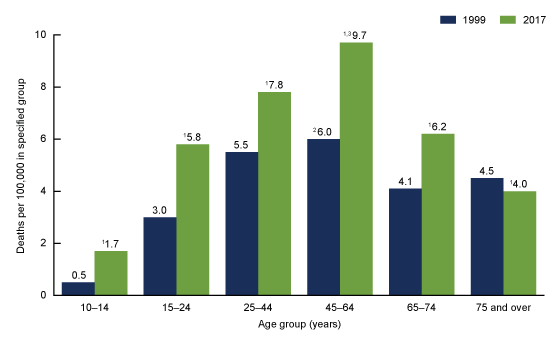
Males:
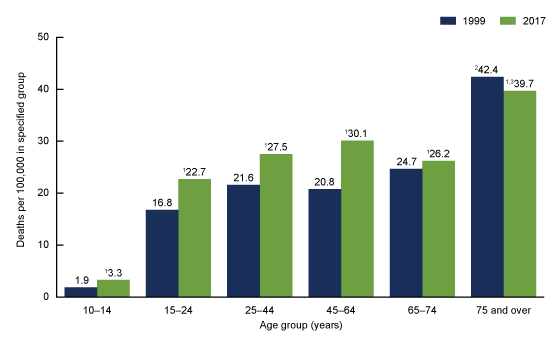
We can combine data sets to the compare suicide rates be age that were present in 1900 to those in 2017. Unfortunately, the age groups used in modern suicide statistics are not the same as those used in the past, and the CDC seems to release these numbers segregated by sex now. Still, we can average across sexes for a rough estimate and some of the age groups have not been changed. Doing so, it appears as if the suicide rate of Americans under 50 is probably higher today than it was in 1900. For Americans under 44, this is clearly the case.
| Age Group | 2017 | 1900 |
| 15 – 24 | 14.25 | 7 |
| 25 – 44 | 17.65 | 14 |
| 45 – 64 | 19.9 | 20 (45 – 54) and 24 (45 – 54) |
| 65 – 74 | 16.2 | 26 (65+) |
| 75+ | 21.85 | – |
Turning away from America, between 1923 and 2001 a similar pattern played out in New Zealand.

From 1955 to 1994, the same occurred in France (though not the former FRG):

And between 1987 and 2012 the same occurred in Japan:

Brazil exhibited the same pattern between 1980 and 2000:

In England, sex segregated data suggests that the suicide rate of people under the age of 35 was roughly the same in 2007 and 1863 while suicide has fallen among people who are older.


Between 1964 and 2000, suicide rates for those under the age of 35 increased in Australia, but they have since fallen back to what they were in the 1960s.

Finally, between 1980 and 2009 suicide rates generally fell in Scandinavia, but this was either less true or untrue of young people depending on the country.

Thus, in the 20th century there was a good deal of diversity in national trends in suicide rates across western countries, but there’s more consistently been a lack of improvement in the suicide rates of young people.
Depression
Turning to self reported rates of depression, between 1905 and the late 80’s, the probability of an American experiencing depression at some point in life increased significantly for every age group.

Research on more recent trends in depression among the general population is contradictory, with some data indicating that not much has changed and other sources suggesting that there’s been a rise in depression rates.



Contemporary research more consistently shows there’s been a fairly large increase in depression among adolescents and young adults:


Even studies that don’t find an increase in the rate at which young people say they are depressed find increases in symptoms of depression like feeling overwhelmed, experiencing more negative emotions than usual, etc.

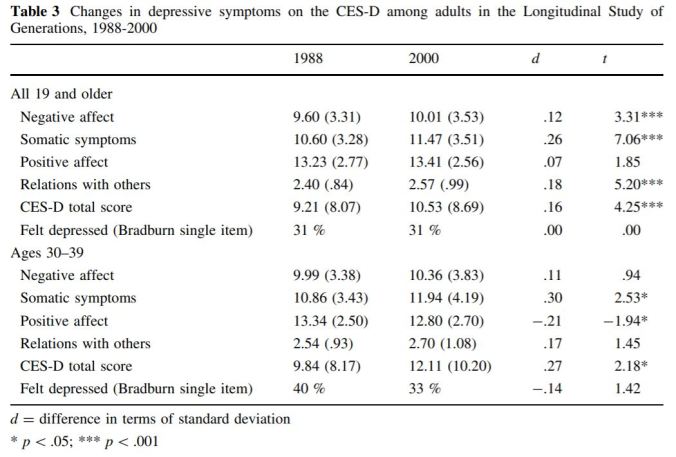
On such measures of depressive symptoms, the mean score of Americans in college and high-school increased by roughly 0.70 SD between 1932 and 2007, a very large change (Twenge et al., 2010)
In Germany and England, rates of depression have been stable for the last few decades.
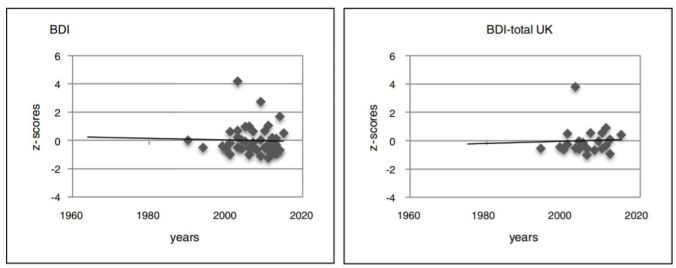

However, mirroring what was seen in America, in England rates of depression among young people rose between 1986 and 2006.


In Canada, a county-wide study has documented a slight increase in total depression rates between 1952 and 1992 which masks a fall in suicide rates among those over 45 and a rise in suicide rates among those over 45.

In Norway, rates of depression increased dramatically between 1930 and 1991 and this was disproportionately due to a rise in depression among those under the age of 60.

Depression rates in Finland have also been rising at least among the young.
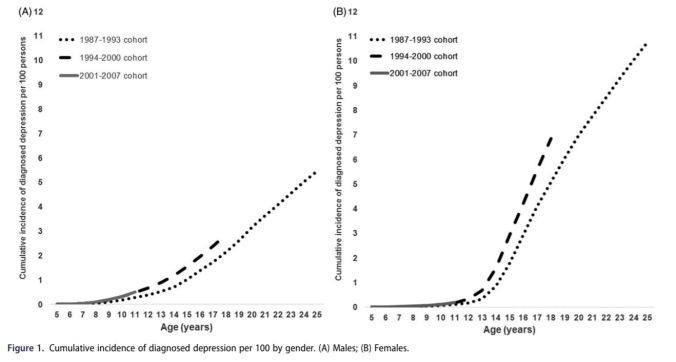
In Denmark, rates of depression nearly doubled between 1995 and 2010 and this was largely due to increased rates of depression among those under the age of 40.


Contrary to these trends, a county-level study in Sweden found that depression rates slightly fell between 1947 and 1997 with this decrease occurring the least among those under the age of 40.
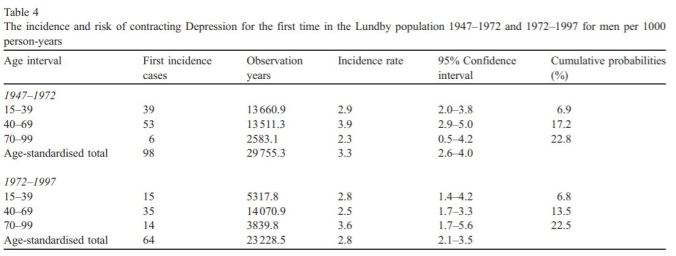

Thus, long term data in Norway, Denmark, Canada, and America suggest that depression rates have risen in these places. England and Germany have had stable overall depression rates while depression among the young rose. Sweden may have seen a decrease in depression but is based on data from a single county and even there this was least true of young people.
Self Reported Happiness and Life Satisfaction
Let’s now turn to surveys which ask people whether they are happy, or satisfied, with their lives. Such polling indicates that the number of people saying they are satisfied with their lives has increased in the EU from around 77% in the early 70s to around 81% today. While positive, this change is minor and the direction and size of change is very dependent upon the exact years chosen for the stop and end point. On the whole, it isn’t obvious that there has been any significant trend in the EU.
Of course, there is a diversity of trajectories contained within the EU. For instance, the proportion of people satisfied with their lives seems to have increased by about 8 points in the UK and Germany between 2000 and 2016. But even in the UK and Germany, there was no discernible trend between 1973 and 2000.

In the United States, self reported happiness is slightly lower today than it was in 1949, but it was higher than it was in 1949 as recently as 2008. There hasn’t been much of a trend one way or the other.

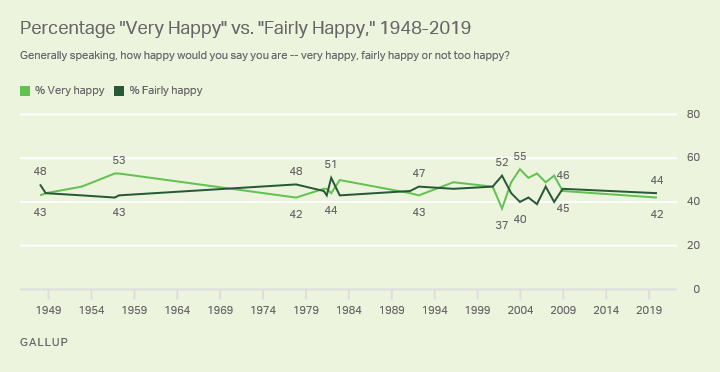
Among US high-school students, neither life satisfaction nor happiness significantly changed between 1976 and 2006.

Upon seeing this evidence, we might think that suicide and depression rates may measure the proportion of people past a certain threshold of negative feeling and that the variance in happiness might increase without the mean decreasing or even with the mean increasing and we’d still see an increase in depression and suicide rates. This explanation is not supported by the data. Over the last 50 years, the variance in happiness has decreased across the West (Ospina et al. 2017).
We might also worry that these sorts of self report measures might suffer from a “reference group effect”. That is, when people are asked how happy or depressed they are, or how often they feel a certain way, they may respond not with their absolute degree of happiness or depression in mind but, rather, according to their happiness/depression level relative to some reference group such as the society they live in, or the one they grew up in, or the people they personally know. If this is so, the mean degree of self reported happiness/depression won’t change much across time even if the absolute degree of happiness is changing quite a lot. This might explain the surprising degree of stability in self reported happiness across the decades. Or it might not. It seems less likely that this explains the trajectories seen in depression rates.
We may further worry that the rate of deaths by suicide will have decrease with time due to the increased speed of medical responses and our improved ability to keep people alive once they are in medical care and this could mask an increase in negative feeling that is taking place.
Conclusion
Other concerns could be generated. This data is far from perfect. But no source of data justifies the view that the progress of the last hundred years had a significant positive impact on psychological well being. And as I’ve already argued, I think this conclusion really does have some quite significant political implications. Drawing out those implications in detail requires a theory of why progress hasn’t improved mental well-being, an explanation which identifies what the hugely negative elements of progress have been. That is beyond the scope of this post, which merely sought to show that such an explanation is in fact needed.
If you need any ideas for stuff to look into, probably the next best thing to cover for the authoritarian view of knowledge thingy would be the more quantitative stuff that is possible to be said about the legacy media. I have some ideas for stuff to say about it, but anything you can dig up would also be appreciated.
LikeLike
(Comment divided into multiple parts due to length)
It’s fine if you disagree with Pinker’s weltanschauung, but the passage quoted above makes it sound like psychological well-being is a subject he completely ignored in Enlightenment Now. In fact, an entire chapter of the relevant book (Chapter 18: Happiness) is devoted to the subject, and indeed discusses/cites quite a few of the studies mentioned in this post. I’m not an expert on this field of research by any means, but based on comparing the evidence and arguments in this post and EN, I’m provisionally convinced that Pinker is correct here. I’ll first address the more concrete empirical issues of suicides, depression/mental illness and life satisfaction, and maybe later discuss the more ethereal and speculative but important philosophical issues that are raised here.
As a preliminary, if readers interested in this subject can’t/don’t want to read the relevant sections of the book, they should consult the relevant Our World in Data articles on Happiness and Life Satisfaction, Suicide and Mental Health, which cover some of the same ground. (Not including the links because doing so can trigger spam filters.)
(I) Suicides
For reasons we’ll get to shortly, I actually don’t think suicides, and particularly fluctuations in suicide rates, are the most important/reliable metric of societal “happiness/well-being,” but since they were the first line of evidence introduced in the OP I’ll discuss them first. I basically agree with the review of the evidence in this section (or at least it’s mostly consistent with what’s presented in EN and at OWID). I would disagree somewhat, however, with the interpretation. On the reliability of suicide rates as an index of overall unhappiness, Pinker writes:
So, I think Pinker provides some reasonable grounds for skepticism towards automatically assuming that suicide rates, given their complex and capricious causes, can be used as a reliable proxy for overall societal well-being. Consider e.g. the gender disparity in suicide rates, which is, according to OWID, globally about 2:1 male:female. That definitely says something about differences between men and women, but I don’t think it would be a logical inference to conclude from that that men generally are living lives that are 2x worse than those of women. The statistics cited by Pinker in the following discussion are basically consonant with the ones in OP, the difference is in the interpretation, which I’ll elucidate later since the case is clearest when all three lines of cited evidence have been considered.
So, Pinker and I would agree that suicide rates have not, as far as the data we have suggests, seen the kind of massive global improvements that things like life expectancy, literacy and per capita GDP have seen over the past couple centuries. However, given that (as I’ll discuss below) the evidence actually suggests that overall self-reported happiness has likely increased substantially, that suicide rates are an imperfect proxy for general happiness, and that, contrary to many conservatives’ belief that the modern world has extremely high or anomalous suicide rates, suicide rates seem within the same ballpark as they were in the past, this doesn’t seem like a strong critique of the thesis that society has gotten better over the past couple hundred years. Of particular importance, it at least doesn’t suggest at a first glance that society has gotten noticeably or much *worse* on net, as the OP acknowledges/agrees. (Though this raises a lot of the broader philosophical questions that I’m trying to defer discussing until I’ve dealt with the more strictly empirical issues.)
LikeLiked by 1 person
(II) Depression
Pinker writes:
So, pertinently here, a major potential issue with a lot of the long-term depression data that the OP cited is that it wasn’t based on standardized tests of symptoms among nationally representative samples. Consequently, it may be biased either by more expansive diagnoses by clinicians or by decreased cultural stigma around depression, both of which I think are highly likely to have occurred over ~1930-2010, and no solid conclusions about long-run trends can be drawn. That’s not to deny e.g. that it looks like there’s been a recent increase in depression among young people, particularly young women, in the US, as Greg Lukianoff and Jonathan Haidt argued in their recent book The Coddling of the American Mind, just that we have no way of confidently knowing how modern society on net compares in terms of prevalence of depression with 75 or 100 or 200 or 500 etc. years ago.
LikeLiked by 1 person
(III) Self-Reported Happiness
This is the section of the OP that I think has both the most serious empirical flaws (by omission) and the most relevance to Pinker’s overall argument about societal progress. Pinker writes:
The most important point being, the OP only looked at changes within already industrialized countries since ~1950. Even within quite a few of these countries, like Germany and the UK cited in the OP, self-reported happiness has been increasing—the US seems to be something of an outlier among developed countries in terms of its wealth/happiness relationship—but the changes in those countries between circa 1950-2000 were considerably smaller, in terms of the things Pinker likes to talk about, than those between 1750–1950. And, while we don’t have the ideal long-term longitudinal data to know this for sure, the apparently very well established global relationship between and within countries between increased wealth and increased happiness and the longitudinal data we do have strongly suggests that people have probably become considerably happier over the past ~200 years as the world has gotten much richer per capita.
LikeLiked by 1 person
Conclusion
Now that I’ve established what I agree and disagree with in the post’s treatment of the empirical facts, I’ll discuss some of the more philosophical/political interpretative issues its data raise.
This post is framed as a critique of Pinker-style neoliberal optimism, but the review of the evidence on suicides, which is mostly the same as that in EN, seems on its face much more like, as Pinker chose to present it, a devastating rebuttal of conservative pessimism of many stripes. The OP commendably noted:
Indeed, but this doesn’t seem like a marginal or ancillary conservative claim, but rather a central and definitive one. Basically every popular alt-right figure, such as Andrew Anglin, Nick Fuentes, E. Michael Jones, Ramzpaul, Stefan Molyneux, etc., claims that life in modern society is much, much worse than it was in the past, usually because of diversity/irreligiosity/capitalism, and that we need urgently radical change completely outside the current paradigm. If suicide is taken as the supreme indicator of societal well-being, the historical and global data provides absolutely no grounds for thinking that that is the case. This is quite remarkable given how confidently and aggressively the pundits mentioned above propound their theories.
Just look at the most popular comments *on the YouTube video of this very post:* pro-Kaczynski anti-Industrial Revolution sentiments, hypotheses (diet, exercise, religiosity) to explain a non-existent, imagined unprecedented modern spike in suicide/depression, “Reject modernity! Embrace tradition!” etc. What’s remarkable isn’t these common (in some circles) sentiments, but rather that these comments are in direct response to a video that provides no evidence supporting them and extensive evidence to the contrary.
The perspective of the OP itself was more nuanced, but I think still fallacious:
For one thing, as discussed above, the supposed paradox of happiness not increasing with running water/modern medicine etc. is illusory, because people in wealthier countries are, at least according to the data we have, generally much happier than people in poorer countries. (As revealed preferences of immigration patterns would suggest.) For another, while it was only briefly and cryptically alluded to here, I would really appreciate even a simple explication of what the hypothesized negative effects counter-balancing modern improvements in health, safety and convenience are. This is because I have a very difficult time imagining what the empirical evidence indicates these could even possibly, let alone credibly, be. Presumably, if this was the case, countries with the positive Industrial Revolution effects but without whatever the supposed negative effects are would have *extremely* high happiness/low suicide rates, but I’m not sure which countries you could possibly point to in which that’s the case. (If there are no currently existing countries where it’s the case, I’m then highly skeptical a priori that it could exist.)
Take, for instance, non-white immigration/ethnic diversity, a subject this blog has discussed. There are plenty of relatively ethnically homogeneous East Asian countries like Japan, South Korea and Taiwan, and ethnically homogeneous Eastern European white countries like Poland and Hungary. They don’t have astronomically better self-reported happiness or suicide rates than Western/Northern Europe/North America/Australasia—indeed, they sometimes have worse. That doesn’t mean that there aren’t valid reasons to oppose immigration/diversity, just that there are no, it would seem to me, valid reasons to suppose that it has some sort of profound importance for the big picture benefits of modernity, as the OP suggests. And I could make similar points with regard to religiosity or capitalism or gender roles or whatever else most alt-right conservatives would point to as the alleged cause of Western society’s supposed disastrous decline.
More abstractly, even if the average level of happiness had simply stayed the same instead of probably increased, and even if suicide rates have remained constant, I think there’s one important way in which you could still contend that modernity has made life better, though Pinker doesn’t make this argument. Namely, given that the world population has increased substantially, from ~1 billion in 1800 to ~7.7 billion today, if people have the same amount of happiness on average, and if that happiness is a net positive for their lives such that they’re glad they were born, but there are more people, then the total amount of well-being in the world has increased, if all else is equal. This raises the thorny issues of population ethics and Parfit’s “Repugnant Conclusion,” but I think a mild form of natalism is compatible with most people’s moral intuitions. (Again, all else being equal, and I think Pinker’s conclusions are valid even without this consideration.)
There’s also (related to above) a potential issue in that people who die prematurely may have much less total happiness than they would if they’d lived a longer life, so as long as they would judge their lives worth living given the choice, the massive increase in life expectancy Pinker cites may well have produced substantial additional happiness as a result even if nothing else had changed.
Finally, I’d conclude that I think Pinker is right about the political implications. All things considered, we have a pretty good system now by historical or international standards. Not to say that there shouldn’t be change, but there’s no reason why we should expect or want that change to be radical, all-encompassing or instantaneous. There’s no obvious model of a present or past society being *much* better by objective metrics that would justify radical or revolutionary change to replicate it. If radicals say that they will quickly create a much better society that no one has ever before created once they’re given absolute power, history suggests that they should not be believed or trusted. (And this is a criticism that both I and Pinker make of the left as much or more than of the right.)
LikeLiked by 2 people
It’s important to recognize that those RW figures mentioned don’t exclusively back their philosophical worldviews with mere empirical claims. That an indicator such as suicide (or the far more nebulous “happiness”) has gone up or down doesn’t tell us much about the overall trajectory of society. To point to the benefits specific technologies have provided us with likewise doesn’t mean much at all re the social order.
LikeLike
“Consider e.g. the gender disparity in suicide rates, which is, according to OWID, roughly 2:1 male:female…I don’t think it would be logical to conclude that men generally are living lives 2x worse than those of women.”
This statement presumes a lot. First, it doesn’t have to be either/or. It could be driven by biological sex differences, and differences in environmental factors affecting psychological well-being, which could in part proceed from the biological sex differences. Secondly, the relationship needn’t be linear. Are there twice as many men whose circumstances drive them to suicide than women? Who knows, but given that suicides are a minority of all deaths, it wouldn’t be difficult for this to be true. We know men generally have lower life expectancy than women in western countries, which could also be due in part to biological sex differences, but also differences in life circumstances, which themselves could be related to biological sex differences.
The difference in the age composition of suicides is actually quite disturbing, and seemingly unaddressed by Pinker. This wouldn’t be inconsistent with my above speculation regarding declining religiosity, as younger generations are generally less religious, but it doesn’t really provide strong evidence for it, either.
LikeLike
All very true, and all perfectly consistent with my point, which was that the massive difference between men and women in terms of suicide rates doesn’t seem to suggest (at least from my point of view) that there’s a comparably massive general difference in terms of life-satisfaction/happiness between men and women generally. (Either in terms of the data or common sense.) It’s perfectly possible that, along the lines you suggest, say, the worst-off 1% of men are worse off on average than the worst 1% of women, or something, and that certainly might be significant, but I don’t think it’s ipso facto very informative about the situation of men vs. women generally.
This (among other issues I raised) demonstrates why I don’t see suicide rates as a really reliable barometer of how society as a whole is doing.
Pinker didn’t discuss it (though he discussed some of the trends w.r.t. self-reported happiness by age). He does, however, discuss the very thorny issues of trying to separate out cohort vs. age vs. zeitgest effects in data over time. (E..g If suicide rates are rising among 50-60 year old Baby Boomers in 2010, does that mean that suicide rates are rising for 50-60 year olds or for people born from 1950-1960?) So I’d be careful of drawing strong off-hand conclusions about those kinds of changes by age unless there’s a very careful analysis of the data.
And, at least so far, it hasn’t made much of a difference to the overall suicide rates, so I don’t see that it’s very disturbing.
Maybe; whatever the effect of religiosity on suicide, and there are some meta-analyses suggesting that it is indeed an inverse/protective one, it doesn’t seem to be very large in a global sense. (E.g. Utah, one of the most religious US states, also has one of the highest suicide rates.)
LikeLike
Sean,
You could’ve looked at self-harm (!), but you forgotten, it seems! (it has increased a lot.)
Also, could’ve looked at taking meds and pills for mental health. (Immediate problem: this stuff was not as accessible and as cheap in the past.)
And since the ‘official religion’ in the US is how good non-White non-cisgerder non-hetero non-males feel, you could’ve looked at it but for our favour: for instance, it’s well-known women are more deppressed now than when they were so-called “oppressed”… I wonder if the same holds water for gays.
LikeLike
Hello
Im non-white black so i may not be welcome here.
Im from a isolated place too
I have lately been looking on the internet and i have diverted into reading on west nationalism the white people, even if I dont understand completely. Ive been not aware of it and this interest has sort of made me feel inadequate. I understand your proudness the west has achieved much great things and glad to share. ITs been hard for me now to look on my other people or me and feel bad. Could be silly but also thinking about myself is it bad to feel that? not being great at who one is I mean. Im told that comparing to other greats without a plan isnt useful but I want to do good and its been confusing if it may be pointless (studying plumping and supporting family).
Sorry for bad english or for asking wrong people. Im new at this, Im reading on WN nad ive been curious
LikeLike
There is IQ variation within races, you can find black people, even racially pure ones who are smarter than the average white if you cherry pick, blah blah, everyone is a snowflake and all that, but the point of all this isn’t “black people are bad” it’s to point out that discrimination against whites isn’t justified and that the ideologies that promote doing so are doomed to fail and cause misery.
LikeLike
what happened to the pakman post
LikeLike
Could suicide rates be impacted by the decline of religiosity among westerners, generally Christians? Christianity historically had a very negative view of suicide, and treated suicides as automatically damned. It’s possible that even those who found life full of only misery might have nonetheless chosen to endure it based on the incentives of eternal reward or punishment. Whereas now many westerners are less religious, and among those who are, many Christian sects have softened their condemnation of suicides, such that an increase in suicides could be due to a smaller proportional pool of miserable people committing suicide at a higher rate, having been “freed” from, or at least less constrained by, fears of divine retribution. But this is speculation, and even if true, it’s not clear whether this is necessarily a point in favor of the Whig View.
It seems like Pinker tries to handwave suicide rates in much the same manner as race denialists seeking to “debunk” heritable racial differences, by pointing out that, yes, many traits or outcomes can be influenced by many different factors, and that this renders general trends moot. Changes, or the lack thereof, in aggregates over the course of decades, are not credibly explained by what the weather was like on a particular day. Perhaps stigma affects the reported rate, but without hard data on its actual impact, this remains speculation.
LikeLike
Great chart in the beginning from Pinker!
Let us put aside Angus Deaton’s ‘Deaths from Despair’ idea, the purposeful propagandizing of credulous Whites into believing they have so much control and ability that they( and they alone) are at fault for all the economic differences in the world. Thus urged to feel guilty by a thousand commercials, news articles and demonstrations, they carelessly off themselves as per instructions. Thus a higher suicide and OD rate.
But what about the ignored spiritual aspect? We live in the age of Economic Man. How much money do you have? What is your number? said the TV ad from a few years ago.My guess would be the medieval peasant who never went more than 7 miles from his church steeple, all his life, all the while grinding away in his fields for his subsistence living, was happier..spiritually, than we with our vacuum cleaner and refrigerator and espresso machine.He or she had a certainty which we have been taught to disparage as magic but others would label Faith that made him happier in the vacant moments when he was planting his wheat or bringing in his sheaves.(Whatever a sheave is?)
LikeLike
Pingback: How Bad Has the US Economy Become for Regular People? (1970 – 2020) | Ideas and Data
Pingback: How Bad Has the US Economy Become for Regular People? (1970 – 2020) – Attack the System
Reblogged this on Muunyayo .
LikeLike
lol. “Net negative.” I’d far rather be psychologically unhappy than die from a myriad of diseases and ailments twenty-times over
LikeLike